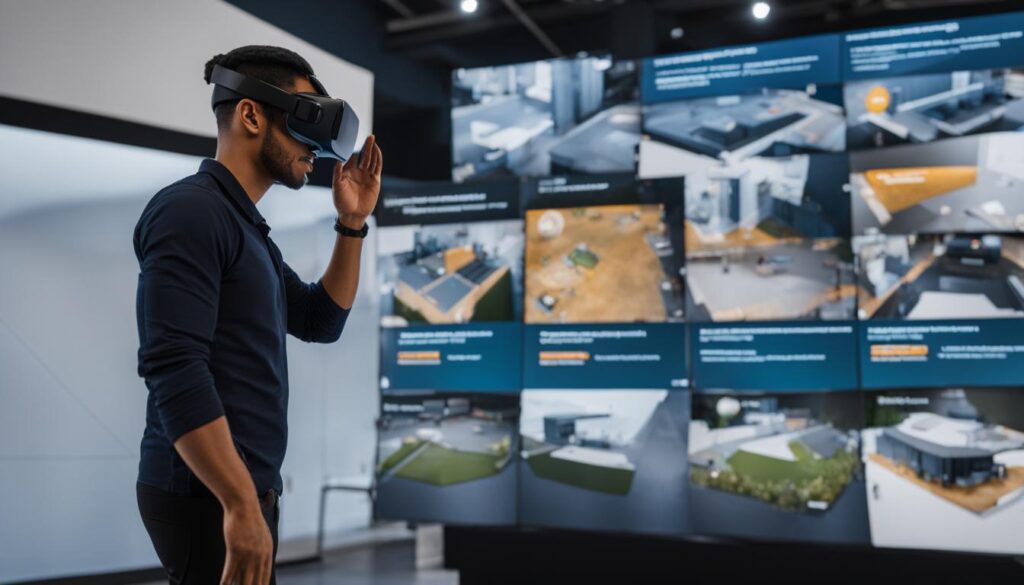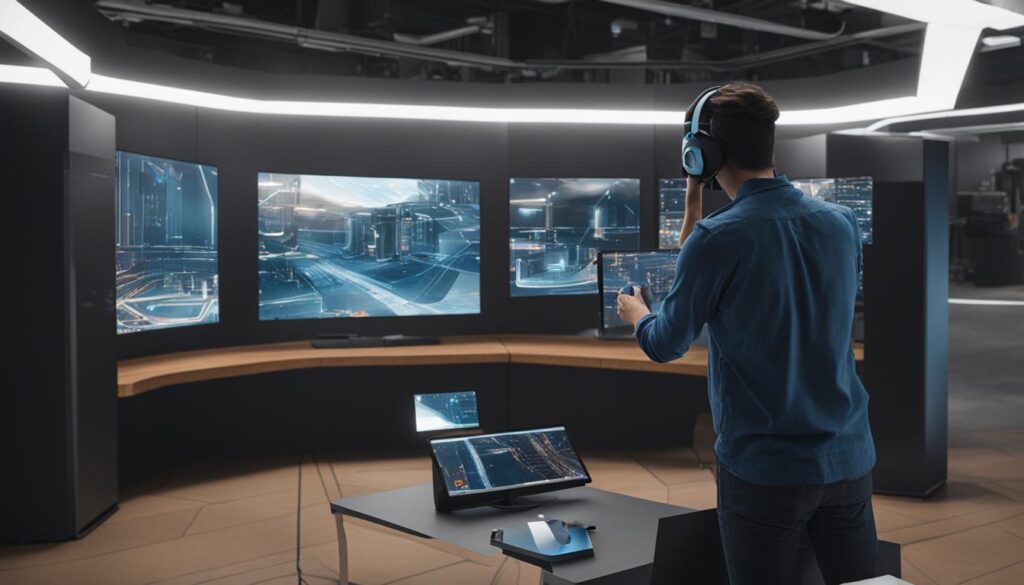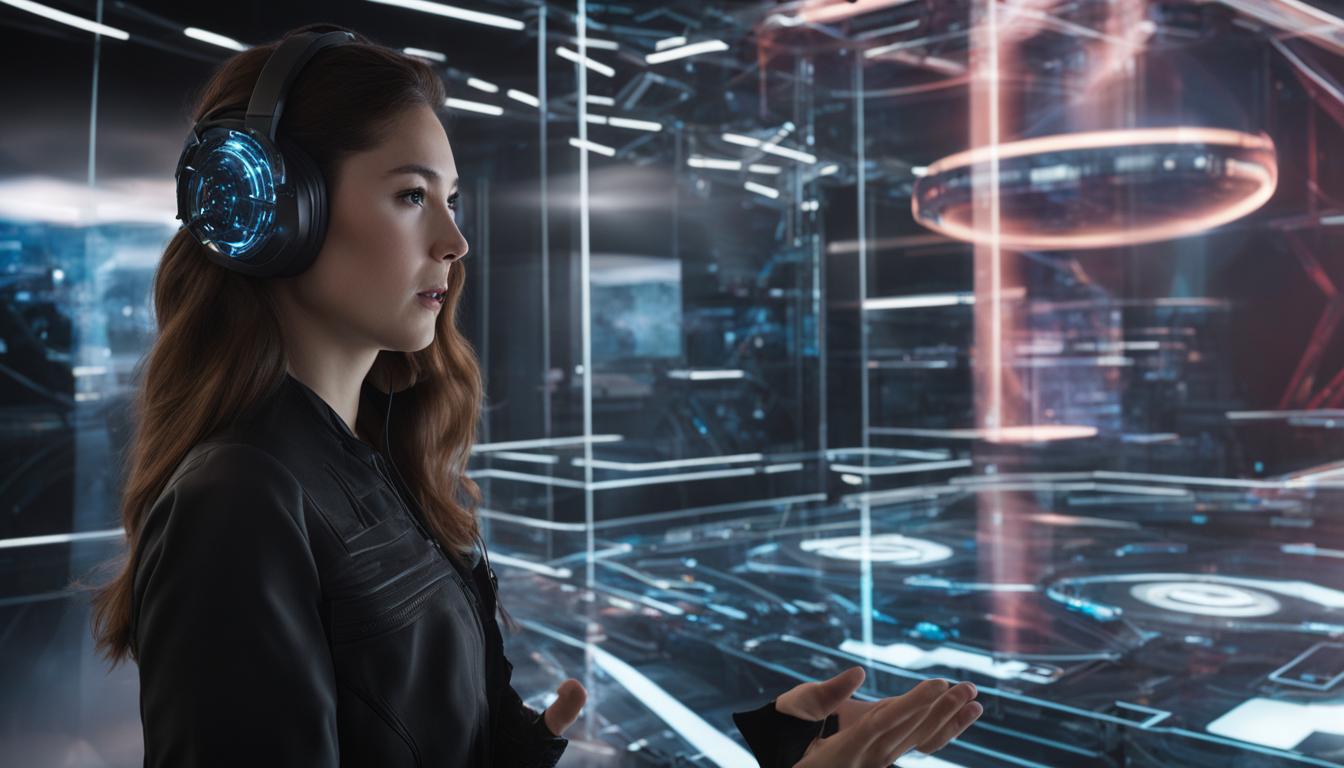Augmented reality (AR) is a powerful technology that offers solutions to various challenges in different industries. By integrating digital elements into the real world, AR can enhance your problem-solving toolkit and provide unique benefits.
In this article, we will explore the applications and advantages of using augmented reality to solve real-world problems. Whether you’re in retail, education, healthcare, or entertainment, augmented reality solutions can revolutionize the way you tackle complex issues.
Contents
- 1 What is Augmented Reality Training?
- 2 Key Benefits of Augmented Reality Training
- 3 The Top 5 Problems with Augmented Reality Training and Their Solutions
- 4 Real-World Examples of Augmented Reality Solutions
- 5 Best Practices for AR Design
- 6 Conclusion
- 7 FAQ
- 7.1 What is augmented reality training?
- 7.2 What are the benefits of augmented reality training?
- 7.3 What are the top 5 problems with augmented reality training and their solutions?
- 7.4 What are some examples of augmented reality solutions in various industries?
- 7.5 Can you provide real-world examples of augmented reality solutions?
- 7.6 What are the best practices for designing augmented reality solutions?
- 7.7 What is the potential of augmented reality for problem-solving?
- 8 Source Links
Key Takeaways:
- Augmented reality (AR) integrates digital elements into the real world to solve challenges.
- AR enhances problem-solving capabilities and provides unique benefits.
- AR solutions are applicable in various industries, including retail, education, healthcare, and entertainment.
- AR technology has the potential to revolutionize problem-solving and create unique solutions.
- By understanding the benefits, challenges, and best practices of augmented reality, organizations can leverage it effectively.
What is Augmented Reality Training?
Augmented reality training is a cutting-edge technology that brings interactive and digital elements to the real world. Through devices like tablets, phones, or headsets, learners can immerse themselves in a dynamic and engaging learning environment. With features such as image recognition, plane detection, and object recognition, augmented reality training allows learners to interact with life-sized 3D objects as if they were physically present. This technology offers a safe and risk-free environment for hands-on learning experiences, making it an ideal solution for various training scenarios.
Interactive Learning in a Digital World
In augmented reality training, learners can actively engage with the content, exploring and manipulating virtual objects in real-time. This interactive learning approach enhances understanding and retention, as learners have the opportunity to interact with realistic representations of objects and scenarios. By actively participating in the learning process, learners can grasp complex concepts more effectively and develop practical skills.
Augmented reality training creates a bridge between theoretical knowledge and practical application. It enables learners to apply what they have learned in a risk-free environment, building confidence and competency.
A Safe and Risk-Free Environment
One of the key advantages of augmented reality training is the ability to create a risk-free environment for learning. Learners can practice complex tasks or procedures without the fear of making mistakes that could have real-world consequences. This immersive and interactive learning approach allows for trial and error, experimentation, and iterative learning, empowering learners to make mistakes and learn from them in a controlled setting.
Furthermore, augmented reality training can simulate hazardous or high-pressure scenarios, providing learners with the opportunity to develop critical thinking, problem-solving, and decision-making skills in a safe environment. By experiencing these scenarios virtually, learners can gain valuable experience and build confidence before facing real-world challenges.
Realistic and Engaging Learning Experiences
Augmented reality training offers learners the chance to engage with lifelike digital models and scenarios. By seamlessly blending virtual elements with the real world, AR training creates an immersive and captivating learning experience. Learners can explore 3D models of objects, observe their behavior from different angles, and interact with them as if they were physical objects. This level of realism fosters active engagement and enhances the learning process by stimulating curiosity, exploration, and discovery.
Additionally, augmented reality training can incorporate gamification elements, rewarding learners for achieving specific goals or completing tasks. This gamified approach boosts motivation and encourages active participation, making the learning process more enjoyable and effective.
Summary
Augmented reality training is revolutionizing the way we learn and acquire new skills. By providing interactive learning experiences in a safe and risk-free environment, this technology offers numerous benefits for learners across various industries. Its ability to merge the digital and physical worlds creates a unique and engaging learning environment that enhances understanding, retention, and practical application. As augmented reality continues to advance, we can expect to see even more innovative applications of this technology in the field of education and beyond.
| Benefits of Augmented Reality Training | Examples |
|---|---|
|
|
Key Benefits of Augmented Reality Training
Augmented reality training offers several key benefits that make it an effective solution for problem-solving in various industries. This section explores the advantages of incorporating augmented reality into your training programs.
Safe Experiential Learning
One of the major benefits of augmented reality training is providing learners with safe experiential learning opportunities. By using realistic digital models, learners can interact with virtual objects and environments without any real-world risks. This allows them to gain hands-on experience and practice skills in a controlled and secure environment.
Dynamic Performance Support
Another advantage of augmented reality training is the provision of dynamic in-the-moment performance support. Learners can access relevant information, guidance, and instructions in real-time, improving their performance and decision-making abilities. This feature ensures that learners have access to the right resources when they need them, enhancing their learning outcomes.
Easy Accessibility
Augmented reality training is designed to be easily accessible and distributed across multiple devices. Learners can engage with AR content using devices such as tablets, smartphones, or headsets, making it convenient for them to access training materials anytime and anywhere. This easy accessibility enables organizations to reach a wider audience and provide flexible learning experiences.
Augmented reality training provides safe experiential learning, dynamic performance support, and easy accessibility, making it an effective solution for problem-solving in different industries.
Take a look at the table below for a comparison of the key benefits of augmented reality training:
| Benefits | Description |
|---|---|
| Safe Experiential Learning | Learners can engage with realistic digital models without any real-world risks. |
| Dynamic Performance Support | Learners can access relevant information and guidance in real-time, improving their performance and decision-making abilities. |
| Easy Accessibility | Learners can access AR training content using various devices, allowing for flexible and convenient learning experiences. |
These benefits highlight the value of augmented reality training as an effective tool for immersive and engaging learning experiences.

The Top 5 Problems with Augmented Reality Training and Their Solutions
Despite its benefits, augmented reality training can also present some challenges. The top 5 problems include technical issues with AR training, limited content capabilities, vendor challenges, immersive limitations, and the need for content updates. Let’s explore each of these problems in detail and discuss the solutions:
-
Technical Issues with AR Training
AR training may encounter technical issues such as hardware malfunctions or content glitches. These issues can disrupt training sessions and affect the overall learning experience. To address these problems, organizations can run pilot programs to identify and address technical issues before implementing AR training on a larger scale. By testing the hardware and content thoroughly, organizations can ensure a smooth and seamless AR training experience.
-
Limited Content Capabilities
AR training may have limited content capabilities, especially for certain training topics that require complex or dynamic interactions. Not all training scenarios can be effectively delivered through AR. To overcome this challenge, organizations should focus on activities and topics that are suited for AR’s capabilities. By aligning the training content with the strengths of AR technology, organizations can maximize the effectiveness of AR training.
-
Vendor Challenges
Working with external vendors for AR training development can pose challenges. Finding reliable vendors who understand the organization’s training objectives and have the technical expertise to deliver high-quality AR experiences can be a daunting task. To address this challenge, organizations should carefully choose vendors with a proven track record in AR training development. It is important to establish clear communication channels and set expectations from the beginning to ensure a successful partnership.
-
Immersive Limitations
Compared to virtual reality experiences, AR training may have immersive limitations. While AR brings digital elements into the real world, it may not provide the same level of immersion as fully immersive virtual reality experiences. However, organizations can consider using alternative AR hardware such as headsets or goggles that offer a more immersive experience. By selecting the right hardware, organizations can enhance the immersion and engagement of their AR training programs.
-
Content Updates
AR training requires occasional content updates to ensure relevancy and effectiveness. Content updates may include adding new training modules, improving existing content, or incorporating industry updates. To manage content updates efficiently, organizations should invest in extended reality systems that allow for easy content creation and updates. By utilizing user-friendly authoring tools and platforms, organizations can ensure their AR training content is up to date and aligned with evolving training needs.
By addressing these problems and implementing the recommended solutions, organizations can optimize the effectiveness of their augmented reality training programs and unlock its full potential.

| Industry | AR Applications |
|---|---|
| Retail | Virtual Try-On for clothes, accessories, and cosmetics AR-based visualization for furniture and home decor |
| Education | AR simulations and visualizations for interactive learning Real-time feedback and immersive experiences |
| Healthcare | AR-guided surgeries for precision and risk reduction Medical training simulations and real-time patient care |
| Entertainment | AR games merging virtual characters with real-world environments AR for live events and interactive marketing campaigns |
Real-World Examples of Augmented Reality Solutions
Augmented reality technology has been applied in various industries, showcasing its potential to revolutionize the way we interact with the world. Let’s explore some remarkable examples that demonstrate the power of augmented reality.
IKEA Place
With IKEA Place, you can bring virtual furniture into your home before making a purchase. This app utilizes augmented reality to allow you to browse and visualize how different pieces of furniture would look and fit in your space. Say goodbye to the uncertainty of online shopping for furniture and make more informed decisions with IKEA Place.
Sephora Virtual Artist
Sephora Virtual Artist is a makeup lover’s dream come true. Using your smartphone, you can virtually try on a wide range of makeup products, including lipsticks, eyeshadows, and blush. This augmented reality experience enables you to see how different shades and products would look on your face, helping you find your perfect makeup match without any actual application.
Pepsi Max AR Entertainment Campaign
Pepsi Max’s AR Entertainment Campaign took advantage of augmented reality to surprise and entertain commuters. By superimposing computer-generated graphics in real-world environments, Pepsi Max created captivating and immersive experiences that left people amazed and engaged. This campaign showcased how augmented reality can elevate marketing initiatives to new heights.
Pokémon Go
Pokémon Go, the global phenomenon that swept the world in 2016, combined location-based technology with augmented reality to create an interactive gaming experience. Players could explore the real world and capture virtual Pokémon using their smartphones. Pokémon Go demonstrated the immense potential of augmented reality in gaming and introduced millions of people to this exciting technology.
Brain Power
Brain Power utilizes augmented reality glasses to provide coaching and support for individuals on the autism spectrum. This innovative application of augmented reality helps people with autism develop social and cognitive skills through interactive and personalized activities. By leveraging augmented reality, Brain Power offers a unique and empowering solution for individuals with autism.
HoloAnatomy
HoloAnatomy is a cutting-edge educational platform that utilizes the Microsoft HoloLens to revolutionize medical education. With HoloAnatomy, medical students can explore detailed holographic representations of the human body, enhancing their understanding and knowledge of anatomy. This augmented reality solution brings a new level of interactivity and realism to medical training.
GAP Virtual Dressing Room
The GAP Virtual Dressing Room enables customers to try on clothes virtually using augmented reality technology. By simply using their smartphones, users can see how different outfits would look on them without the need to physically try them on. This convenient and immersive shopping experience merges the digital and physical worlds, making clothes shopping more efficient and enjoyable.

These real-world examples demonstrate the diverse applications of augmented reality in various industries. From enhancing shopping experiences to transforming medical education, augmented reality continues to push boundaries and unlock new possibilities. As technology advances and more creative solutions emerge, we can expect to see augmented reality playing an increasingly prominent role in our everyday lives.
Best Practices for AR Design
When it comes to designing augmented reality solutions, following best practices is crucial to ensure optimal user experience and successful implementation. Incorporating problem-focused design, selecting the right platforms and interaction modes, paying attention to content and interface design, as well as testing and iteration are key elements in creating effective AR experiences.
Problem-Focused Design
With problem-focused design, you need to identify the specific challenges your users are facing and understand their goals and context. By doing so, you can tailor your AR solution to address their needs and provide relevant and effective problem-solving capabilities. This customer-centric approach is essential in creating meaningful and impactful AR experiences.
Platform Selection
Choosing the appropriate AR platform is crucial as it determines the hardware and software requirements of your solution. Consider factors such as the target audience, environment, and device compatibility. This ensures that your AR experience is accessible and optimized for the devices your users are most likely to have.
Interaction Modes
Interaction modes play a vital role in AR design, allowing users to engage with the digital elements seamlessly. Depending on the context and objectives of your solution, consider different interaction modes such as touch gestures, voice commands, or even hand tracking. By selecting the most intuitive and user-friendly interaction modes, you can enhance the overall user experience.
Content and Interface Design
AR content and interface design should be relevant, clear, consistent, and adaptable. Ensure that the digital elements seamlessly integrate into the real world and provide meaningful information or interactions. Consistency in design elements, such as icons, buttons, and menus, helps users navigate the AR experience intuitively. Additionally, adaptability allows for customization based on user preferences and different use cases.
Testing and Iteration
Testing and iteration are essential steps in refining your AR solution. By gathering feedback from real users, you can identify areas for improvement and address any usability issues. Conduct user testing sessions, observe how users interact with the AR experience, and gather valuable insights. Iterate based on the feedback received to ensure a seamless and engaging user experience.
Implementing these best practices in AR design will significantly increase the chances of creating impactful and successful solutions. By focusing on problem-solving, selecting the right platforms and interaction modes, designing user-friendly content and interfaces, and continuously testing and iterating, you can deliver AR experiences that meet the needs and expectations of your users.
Conclusion
Augmented reality (AR) has tremendous potential to revolutionize problem-solving across industries. As AR technology continues to advance and become more accessible, it is crucial for organizations to embrace its potential and explore innovative ways to leverage it for real-world challenges.
By understanding the benefits, challenges, and best practices of augmented reality, organizations can enhance their problem-solving toolkit and create unique solutions. AR’s ability to integrate digital elements into the real world opens up a world of possibilities for businesses, educators, healthcare professionals, and entertainment providers.
The future of AR is bright, with continual advancements driving its adoption and expansion. As the technology evolves, more industries will embrace AR to deliver enhanced experiences, improve efficiency, and solve complex problems. Embracing AR technology now positions organizations at the forefront of innovation and gives them a competitive edge in their respective fields.
Now is the time to embrace AR technology and unlock its potential. By staying informed and proactive in adopting and integrating augmented reality into existing workflows, organizations can position themselves for future success and remain at the forefront of their industries.
FAQ
What is augmented reality training?
Augmented reality training is an extended reality technology that brings interactive, digital elements to the real world. It allows learners to experience a dynamic and engaging learning environment using devices like tablets, phones, or headsets.
What are the benefits of augmented reality training?
Augmented reality training offers safe experiential learning, dynamic performance support, and easy accessibility. It provides learners with a risk-free environment to interact with realistic digital models, access relevant information in real-time, and engage with the content using multiple devices.
What are the top 5 problems with augmented reality training and their solutions?
The top 5 problems include technical issues with AR training, limited content capabilities, vendor challenges, immersive limitations, and the need for content updates. These problems can be solved by running pilot programs to address technical issues, focusing on activities suited for AR’s capabilities, carefully choosing vendors, considering alternative AR hardware, and investing in extended reality systems for easier content updates.
What are some examples of augmented reality solutions in various industries?
Augmented reality solutions can be found in industries such as retail, education, healthcare, and entertainment. Examples include IKEA Place for virtual furniture placement, Sephora Virtual Artist for trying on virtual makeup, Brain Power for autism coaching, and GAP Virtual Dressing Room for virtual clothes try-on.
Can you provide real-world examples of augmented reality solutions?
Yes, some notable examples include IKEA Place, Sephora Virtual Artist, Pepsi Max AR Entertainment Campaign, Pokémon Go, Brain Power, HoloAnatomy, and GAP Virtual Dressing Room.
What are the best practices for designing augmented reality solutions?
Best practices include taking a problem-focused approach, selecting the appropriate AR platform and interaction modes, designing relevant and adaptable content and interfaces, and testing and iterating the solution with real users to gather feedback and make improvements.
What is the potential of augmented reality for problem-solving?
Augmented reality has the potential to revolutionize problem-solving in various industries. As AR technology advances and becomes more accessible, organizations can leverage its benefits to enhance their problem-solving toolkit and create unique solutions.




